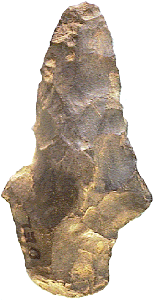

Point Type: RANDOLPH
Also See: Bradley Spike, Flint River,
Schild Spike, Duval, Mountain Fork, New Market
Location: Far Eastern United States
Associated Dates:
2000 - 200 B.P.- Woodland to Historic
Morphology: Stemmed
General Description: The Randolph arrowpoint is a small to medium sized, narrow, thick, crudely made with poorly controlled flaking resulting in sometimes highly asymmetric outlines. Overall a spike point with tapered shoulders, a median ridge, and a medium contracting rounded short stem. The blade is thick and narrow, parallel sided to triangular in outline. The shoulders are obtuse to angular. Some examples exhibit one shoulder barb which is highly exaggerated in size when compared to the other shoulder barb. It appears that many Randolph points were fashioned from waste flakes or conserved, broken points from earlier periods. The Bradley Spike is almost identical in size and description and is probably a Tennessee derivation. Justice suggests that the Randolph is perhaps a correlate to the Ledbetter Cluster of points (Ledbetter and Pickwick types).
Coe believes "The Aboriginal culture in the Piedmont area disintegrated rapidly after 1700 A.D. The Randolph was made between 1700 A.D. and 1800 A.D. by aboriginal cultures in the Piedmont area who lived in small destitute bands and who could not continually supply themselves with adequate guns and ammunition. As a result they found it necessary to return to the bow and arrow for hunting and exhibition. These groups gave birth to the point type known as the Randolph Stemmed"
The Randolph is primarily found in North Carolina, and eastern Tennessee. It is found in decreasing numbers in adjoining states.
The Randolph point ranges in size from 25 mm to 55 mm in length. The width across the barbed shoulders ranges from 15 mm to 25 mm. The stem length ranges in size from 9 mm to 16 mm long. The stem width ranges from 9 mm to 17 mm. The Randolph point was named by Joffre L. Coe in 1964 for examples he found in Randolph County, North Carolina.
About the Point Above: The point pictured above is a large sized Randolph point. This specimen is made from a dark brown and gray glossy flint. The point measures 51 mm in length, 27 mm at the widest point (across the shoulders) and is 11.5 mm thick at mid blade just above the shoulders. The hafting area thins down to 5 mm in thickness and is 10.5 mm wide. The stem is 15 mm long. The basal edge is rounded and is not ground. The point is very crudely knapped and is wonderfully asymmetric in outline. The point is obtuse. The point shows the signs of fire pocking in the form of small circular craters which are on both sides of the specimen (see tip area and lower stem). This point was a surface find in corn fields along the James River, near the town of Hearns Crossroads, Sussex County, Delaware. Catalog Number 71-6-A
References: Baker, Dragoo (f), Fogleman, Justice, Overstreet, Perino (1, 4)
© Copyright 1997 - 2008 LITHICS-Net WWW.LITHICSNET.COM
Use Your Browser's BACK Button to Return to the LITHICS-Net Index.